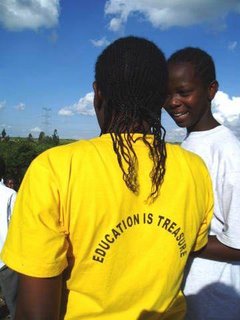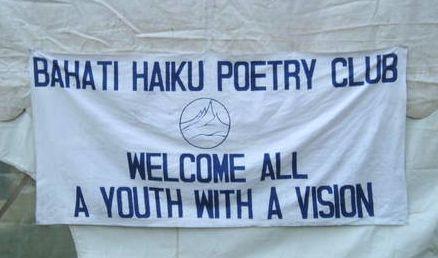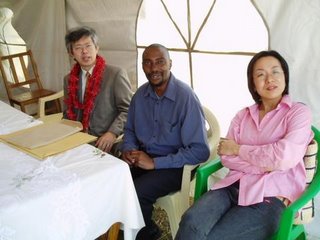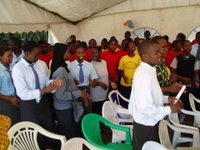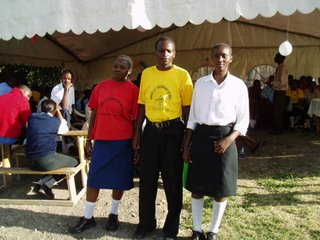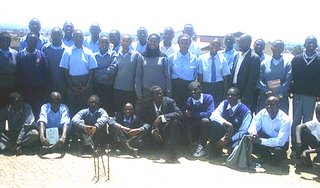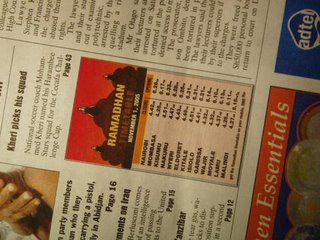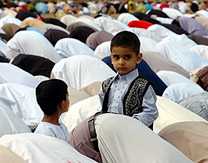[ . BACK to WORLDKIGO TOP . ]:::::::::::::::::::::::::::::::::::::::::::::::::::::::::::::::::::::::::::::::::::::::::::::::::::::
St Valentine’s Day (Valentine’s Day, Valentine)
***** Location: Kenya
***** Season: Hot dry season
***** Category: Observance *****************************
Explanation
Despite the little knowledge about its origin, the majority of Kenyans, especially the urban folks, believe Valentine to be the celebration of love. The colour red is the predominant mark for this day, and it is exhibited in flowers and clothes.
In Nairobi, St. Valentine's Day is highly commercialised. Flower, clothes, shoe and other accessory vendors and supermarkets, as well as hawkers, capitalise on this occasion and stock red coloured Valentine's items at strategic points to attract customer attention. Since red roses are expensive and in short supply, traders substitute them with plastic ones. Husbands and wives buy each other gifts and flowers and they dress in red; so do lovers. Couples go out to exclusive joints to spend a romantic moment together. Restaurants, hotels, pubs and resorts are decorated in red and special entertainments and menus are prepared to match their clients' needs.
The best climax about St Valentine's Day however is the renewal of love vows and re-affirming love and faithfulness to each other in our relationships.
 A whirl of red synthetic roses with a bottle of grape drink
A whirl of red synthetic roses with a bottle of grape drinkText and photo © Patrick Wafula
:::::::::::::::::::::::::::::::::::::::::::::::::::::::::::::::::::::::::::::::::::::::::::::::::::::
This year, 2012, I was amazed by the ingenuity of Nairobi business people with regard to St. Valentine’s Day. This time round they went a notch higher with the Valentine affair. To start with, a couple of days prior to St. Valentine’s Day, they put up flower tents on almost every major street in the city centre. The flower tents were complete with smartly dressed sales people; the red flowers, which are usually synthetic (plastic), were this time round mingled with real fresh red roses. Secondly, to make it even more fabulous, the flowers were wrapped along with other beautiful gifts such as red teddy bears, chocolate, ribbons, or small, cute traditional reed baskets. The prices varied depending on the package. A whirl of real red roses cost as much as Kshs. 1,200. A teddy bear could even cost Kshs 2,000.
The supermarkets too were more creative. They set up Valentine stands right in the entrances, all shrouded in red. They offered very attractive Valentine packages with alluring gifts. All packages
included at least a red flower and ribbons. But some packages contained not just flowers and beautiful wrappings, but red wine, hot chocolate and huge teddy bears with fantastic love messages, such as “I am Thinking of You, My Thoughts Are Inside,” scribbled across them. A gift wrap with a bottle of wine, sweets and a chocolate bar cost around Kshs. 1,300.
 Valentine’s Day stand at Tuskey’s, Moi Avenue
Valentine’s Day stand at Tuskey’s, Moi AvenueNairobi city centre last evening was engulfed in romantic shopping sprees with supermarkets remaining open up to 9.00pm to serve their ravenous Valentine clientele. Hawkers too, strategically positioned all around the city, were making a kill; they sold the flowers and gifts at a more reduced price than the supermarkets.
Kenyans may not be as romantic as Nigerians, but I can assure you, they are pretentiously romantic: during day time, they harbour severe faces and religious behaviours, but at night, as darkness descends over the land, they turn vivacious, lascivious and openly romantic.
Valentine —
a red ribbon fluttering
on a matatu mirror
Moi Avenue —
an abandoned
red plastic flower Text, haiku and photo © Patrick Wafula
:::::::::::::::::::::::::::::::::::::::::::::::::::::::::::::::::::::::::::::::::::::::::::::::::::::
Unusually for a saint, St Valentine’s Day is not usually celebrated in church. The reason is that he lived so long ago, that no one is quite sure whether the stories about his life are true, or whether they have grown over the centuries without there being a firm basis of truth. On the other hand, when St Valentine's Day falls on a Sunday, the churches usually take the opportunity to talk about love, loyalty and faithfulness to one's partner.
It is to find red roses in Nairobi on St Valentine’s Day. Kenya produces the greatest number of roses exported in the world, many of which are red, and almost all of which come from around Lake Naivasha. But as the export trade is so strong for red roses around St Valentine's Day, there are usually insufficient of them left for Kenya itself! Every night, there are several Jumbo Jets flying out of Nairobi, loaded with nothing but flowers (mostly roses, as it happens)...
loading the plane --
surrounded by the scent
of St Valentine'sWith its huge variety of other offerings in red, Kenya has truly made St Valentine's Day its very own festival.
 Preparing an arrangement of red roses at City Market, Nairobi
Preparing an arrangement of red roses at City Market, NairobiText, haiku and photo © Isabelle Prondzynski
***************************** Worldwide use
WKD : Valentine's Day 2012 *****************************
Things found on the way
Haibun In Nairobi ’s Kayole / Soweto slums where I live and work, February is usually a dry dusty month full of dusty breezes. But the sunrises are gloriously splendid. You wake up guaranteed a golden orange sun and an azure-blue sky. But on 14 February 2009, I celebrated a unique Valentine like none other I had ever had. I dated a person living with HIV/AIDS.
Valentine’s day--
red roses displayed
on dusty roadsides17: 05 hours: I did not know what could be the best gift for my date as I closed and locked my office. I started off to our rendezvous — her flat. It was a lovely evening with a cool breeze sweeping across Soweto slum, mildly stirring up a little dust here and there, and sometimes a whole litter of polythene bags floated in the dark blue evening sky. Most of the young cute-looking people I met on the streets were either fully or half dressed in something red or at least had something red tagged somewhere on their cloth.
students crowding
a lush red coloured stall —
Valentine’s cards
Romanticism was slowly enveloping Kayole and Soweto slums in the twilight; the boldness of the uniformed students in pairs bargaining for Valentine Cards and gifts that were variously and creatively designed to offer variety totally mesmerized me; this scenario pushed me a notch higher on the Valentine Richter Scale. I was pressed for time. Not only was I required to accomplish my date with Miss L. (not her real name -- names are not mentioned here for confidentiality reasons), but I was also required to take my wife out on a date to Nyama Villa and later throw a late night family party with for our three daughters Faith, Esther and Liz.
Valentine ballads —
nostalgia for memories past
burns me upLet me tell you more about my work. I work in a community secondary school based in Nairobi ’s Kayole Soweto slum. The school has a mixed population of both boys and girls of about 600 students aged between 13 and 18. But sometimes we receive extraordinary and unusual students not only in age, but also in background and experience. Some are aged over twenty and some are just below twenty but their experiences are flabbergasting. The oldest student we have ever received was Master R who was aged twenty-six in 2005. Master R completed his KCSE examination in 2008 and is now a teacher.
In fact, our school is a very special centre that mends broken dreams, lives, brains, hopes and hearts. For the seven years I have worked here, though, the year 2009 was an exceptional year for me. For the first time, we had two students, Miss M and Miss D sitting their KCSE exams with distended blessings in their wombs. And for the first time, we also had two students living with HIV/AIDS in our midst. They were Miss B and W. Of course I do not imply that we have never had teenage pregnancies in our school before; far from it. In fact, we do have them every year, even though our statistics for the last five years—2005-2009—show a sharp decline. The fact is that in 2009 we did not treat these cases in the usual tradition of expelling and stigmatizing. Instead, we showed sensitivity, understanding and moral as well as psychological support. We advised them to sit their exams and sternly cautioned all the other students against any form of discrimination and stigmatization. The question that triggered this was:
“Why haven’t we, as a society, ever expelled or stigmatized the boys or men who usually impregnate these girls? Why should the girls carry the burden of pregnancy alone, while the boy or man with whom they shared the pleasure of pro-creating is allowed to go on with his life totally uninterrupted?”
she is too large
to fit in between the desk —
her distended tummyThank God for our Government for endorsing this new policy. The girls can now sit their exams even if they are pregnant!
she tells a female teacher
that she’s older than her —
student mother
Our school also broke the record among community schools in 2009 for allowing two student mothers to study and sit their KCSE exams. The most outstanding was Miss E, who had been forcibly married off at the age of 16, due to poverty in their family. She had with much difficulty given birth to two children by the time we caught up with her in her matrimony. With the help of the authorities, we managed to extricate her from the abusive marriage. She joined our centre in 2007 and successfully sat for her KCSE exams in 2009. She had dropped out in Form 2. She had come to the centre with a broken heart, body and brain, as well as spirit, but she left the centre a healed, pretty girl in specs. She was very close to my wife.
sharing SMSes
from her ex-husband—
student motherGenerally, our students are the most beautiful-looking in the whole slum. With their resplendent uniforms and proud looks and posture, they usually attract so many others to the school. But underneath these beautiful faces and uniforms, are resilient spirits who have fought all forms of social and economic evils: drug abuse, teenage pregnancy, HIV/AIDS, abject poverty, sex abuse and molestation, domestic violence and child labour. The year 2009 was also extraordinary because we had admitted the two students living with HIV/AIDS.
18:10 hours: At the market stall, I struggled undecidedly with Valentine’s cards and gifts to buy for my date. The cards and gifts, although all in red, differed in size, decorations and material and hence the variation in prices. In the background, ballads, vehicle honks and the usual market din and the hawkers’ monotonous sales slogans and stories blared on. I finally settled for a small but cute Valentine’s gift for Miss L. It was a nicely woven traditional basket made from wild date palm reeds. It had a huge fully bloomed red plastic rose at the centre with red ribbons fluttering all around the red rose and the basket. There was a simple love message scribbled on a rectangular paper glued to the side of the basket:
To Someone very SPECIAL,
On this Valentine :
I LOVE YOU! Thinking of you : Valentine’s chocolates
Thinking of you : Valentine’s chocolates18:30 Hours: It was getting dark and twilight was fading into night, but colourful lights kept shooting into life from all buildings around, thus brightening the night. Night clubs, pubs and all entertainment joints were Valentine red in lighting and decoration.
I arrived at Miss L’s flat and knocked on the door. It was a high-rise building with several other tenants in it. As I stood outside her door waiting for it to be opened, I noticed that it was smeared with several stickers, all carrying HIV/AIDS messages. But the most outstanding sticker was the one with the President holding hands in a tight circle with people of all ages, classes and religions. And the poignant message on it was:
“Tuungane
Tuangamize
UKIMWI!”
“Let us unite
to eradicate
HIV/AIDS!”I read this message over and over again as I waited for the door to be opened. Soon there was a click and the door opened. And before me, a beautifully dressed lady in jeans trousers, open shoes and red T-shirt, stood before me in the light-flooded sitting room, smiling sweetly, but her eyes were sad and lonely. That was Miss L. She had done a lot for the community — rescuing girls and women who suffered from HIV/AIDS stigmatization and discrimination. Our school had formed a network with her organization for the same reason; she had been the first girl in this part of Nairobi to publicly declare her HIV status.
I held the gift out to her and watched as pleasant shock and surprise engulfed her; she pouted the surprise. I silenced her with a hearty embrace and two pecks on both cheeks. The light that sparkled in her dark lonely eyes as she whispered:
“Do you mean you love me this much?” made my Valentine.
“Yes,” I said, “You deserve much much more. You have made a difference in so many lives here.” We released each other. “But I’m afraid I won’t stay. I’m taking my wife out to Nyama Villa and we have a family party later to-night.”
“I’m so grateful you thought of me, Pat. You’ve made my Valentine.”
“Don’t mention it”, I said and kissed her Happy Valentine.
Valentine’s date
with a HIV/AIDS person--
the radiance in her eyes
a red night
of eating chicken and dancing jazz —
dating my wife
church flower garden --
two little girls exchanging
red hibiscus flowers~ Haibun and photo © Patrick Wafula
*****************************
HAIKUSt Valentine’s Day --
today the computer
is my only love
St Valentine’s Day --
all the church finery
for a wedding
St Valentine’s Day --
the church warden mourns
his late wife
Valentine’s Day --
a lovers’ quarrel going
round and round my head
Valentine's Day --
who may be thinking of me
right now?~ Isabelle Prondzynski
 from Japan, with KitKat chocolateValentine's Day -
from Japan, with KitKat chocolateValentine's Day -
I send you a sweet
postcard~ Gabi Greve
xxxxxxxxxxxxxxxxxxxxxxxxxxxxx
Valentine's day --
a girl's red tongue licks
a red ice cream~ Dennis Wright
red flowers --
the leftovers colour
the market~ Peninah Wanjiru
Valentine's day --
she covers her neck
with a red scarf~ Ezekiel Mbira
sudden odour --
I stare at the roses
in the market~ Meg Ndinda
:::::::::::::::::::::::::::::::::::::::::::::::::::::::::::::::::::::::::::::::::::::::::::::::::::::
 A traditional reed basket full of Valentine’s Day gifts
A traditional reed basket full of Valentine’s Day giftsPhoto © Patrick Wafula
:::::::::::::::::::::::::::::::::::::::::::::::::::::::::::::::::::::::::::::::::::::::::::::::::::::
Valentine --
a little girl undusts
her fallen flowers
red decorations
on the pear vendor’s wheelbarrow --
Valentine’ Day
youthless church
for the morning service --
Valentine’s Day~ Hussein Haji
a couple kiss
across the bus station--
Valentine’s day~ Kelvin Mukoselo
Soweto market --
loudspeakers advertise
Valentine products
Valentine’s morning --
vendors arrange flowers
in the wheelbarrow
Valentine’s day --
a flower hawker whistles
from door to door~ Caleb Mutua
Valentine’s card --
some sweet melody plays
in the pub
a chocolate pack
in heart-printed wrappers --
Valentine’s gift
Valentine’s Day --
bouquets of red roses
displayed in the shops~ Gladys Kathini
Valentine's Day --
people in red clothes on their way
carrying flowers~ Samuel Ndung'u
in a red suit
a man carrying flowers --
language of love~ Raymond Otieno
stout lady
clutching red roses
clad in red
twenty bob each!
shouts a jovial hawker --
red bouquets~ Catherine Njeri Maina
people in red
laughing and cheering in the pub --
Valentine’s night~Walter Otieno
:::::::::::::::::::::::::::::::::::::::::::::::::::::::::::::::::::::::::::::::::::::::::::::::::::::
 Teddy bears for a Valentine!Photo © Patrick Wafulawaiters in red
Teddy bears for a Valentine!Photo © Patrick Wafulawaiters in red
serving red wine --
Valentine's Day
couples in red
cluster around flower stalls --
red twilight
a couple quarrelling
over Valentine SMSes --
sulky facesform one students
asking the English teacher --
what is Valentine
Muthurwa --
hawkers of Valentine’s gifts
block the pathwaysLuthuli Avenue --
broken roses scattered
at zebra crossings
Valentine’s Eve --
the shoe vendor's stall
gradually turns red~ Patrick Wafula
*****************************Related words*****
WKD : Valentine's Day 2012 [ . BACK to WORLDKIGO . TOP . ]:::::::::::::::::::::::::::::::::::::::::::::::::::::::::::::::::::::::::::::::::::::::::::::::::::::


